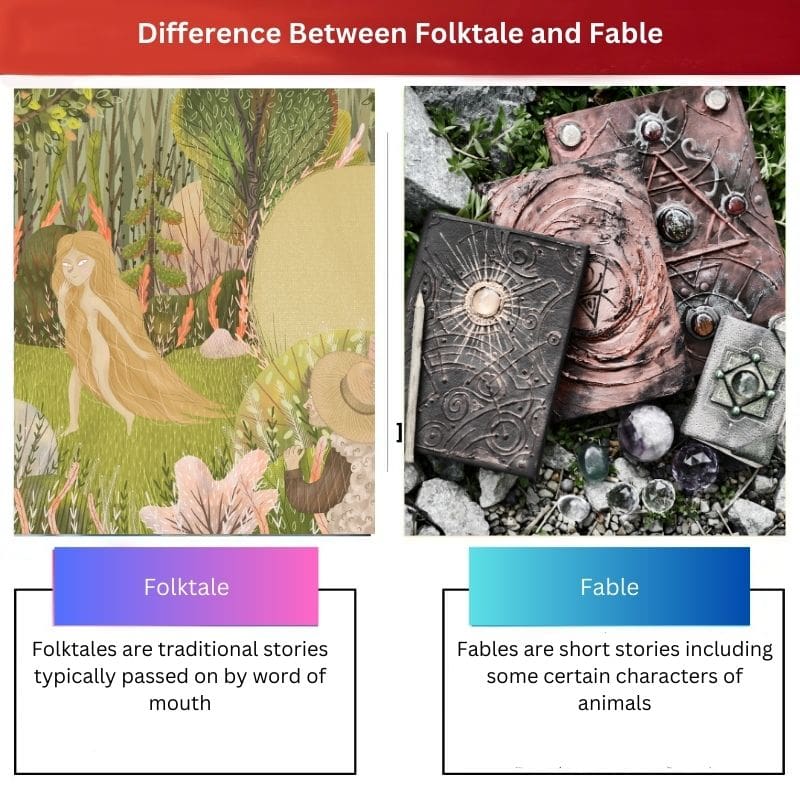When we talk about folktales and fables, we consider these two as having the same meaning or the same thing. But there is a lot of difference between these two words.
Folktales and fables are two different types of stories. A folktale is a type of story that arose from popular culture and then passed on by word of mouth.
On the other hand, fables are also a type of short story of characters of different animals and have some morals.
Key Takeaways
- Folktales are traditional stories passed down through generations, whereas fables are fictional tales with moral lessons.
- Folktales involve human characters or animals with human-like qualities, while fables primarily feature talking animals.
- Folktales have diverse cultural origins, while fables originate from ancient Greece and Rome.
Folktale vs Fable
A folktale is a traditional retold story that is passed to different generations through society and does not have a specific author. Not all folktales have a moral lesson. A fable is a short story that is written by authors and always has a lesson or moral stated at the end of a fable.

A folktale is a traditional retold story that is passed on in a variety of ways in society. Folktales never have authors. They just pass from person to person.
Every country has its folktales that belong to its history and culture. Folktales have different types of characters, including humans, animals, evils, demons, etc. Not all folktales have moral lessons.
Fables are short stories that are written by authors. Fables always have some morals or lessons. Usually, the moral lessons are stated at the end of the fables.
Fables are certain types of stories, including some characters like animals, plants, or any other characters who act like humans due to their human qualities.
Comparison Table
| Parameters of Comparison | Folktale | Fable |
|---|---|---|
| Definition | Folktales are traditional stories passed on by word of mouth | Fables are short stories including some certain characters of animals |
| Morals | Folktale have no morals or lessons | Fables always have morals or lessons at the end of the story |
| Author | Folktale never written by authors | Fables are always written by authors |
| Characters | Humans, demons, evil, supernatural creatures | Plants, animals, and mythical creatures |
| Variations | Different variations | Uniform or specific variations |
What is Folktale?
Folktales are those stories that have been told by several people over the years. These stories do not belong to any person. Folktales have been told over the years in a culture and have moved on to the next generation with a few changes.
These stories have been passed down from ancestors to the younger generation. Folktales are based on different facts. Not all folktales have lessons or morals.
Folktales vary from person to person. Each folktale belongs to the culture and history of different countries. There is no restriction on the number of people in the folktales.
Folktales are long stories. Human beings are the main characters of every folktale. A folktale also can be a fairy tale, a historical story, a ghost story, or even an adventure story. Commonly types of folktales include:
● Fairy tale
● Trickster tale
● Myth tale
● Origin tales
Folktales can help children by improving their strong reading skills, modelling positive character traits, or studying other cultures. Folktales reflect the values of the culture. Some examples of folktales are as follows:
● Wonder tales
● Romantic tales
● Animal tales
● Realistic tales
● Tales of Magic
● Love story tales
● Tales of the Stupid Ogre
● Funny tales

What is Fable?
Fables are the type of short stories in which characters of animals, mythical creatures, plants, and other characters act like a human.
Folktales are always written by authors. They always have some morals and lessons at the end of the story. Fables are restricted to a jungle or any outside area.
Some examples of fables are as follows:
● The fox and the grapes
● The tortoise and the hare
● The lion and the mouse
● The fox and the crow
The characters of animals give the impression that they belong to life and act like humans. Fables can be described in a variety of ways. Each fable consists of 2 or 3 animal characters. Fables never include humanoids.
Fables are false stories, but authors write them to convey a short moral or any lesson for children so that they can focus on it. They are based on areas of the jungle. Types of fables are as follows:
● Animal fables
● Fables of the plant kingdom
● Mythological
● Agonal
● Etiological
In fables, all the characters have certain criticism behaviour. Fables are short fictional stories. Fables always have uniform variations. Some characteristics of fables are as follows:
● Fables are fiction stories
● Characters of animals with human aspects
● They are just one story
● A lesson or moral is taught always written at the end of the story
● Fables always have few characters
● Fables are short in length

Main Differences Between Folktale and Fable
- Folktales have no specific characters, while fables have specific characters.
- Folktales have no author, while fables have authors.
- Folktales may have or may have no morals. On the other hand, fables always have some morals or lessons.
- Folktales have a mixture of different characters, including humans, demons, and supernatural powers, while fables also have a mixture of different characters, including animals, plants, mythical creatures, or any similar characteristics that are given human qualities.
- Folktales have different variations, while fables have uniform variations.



